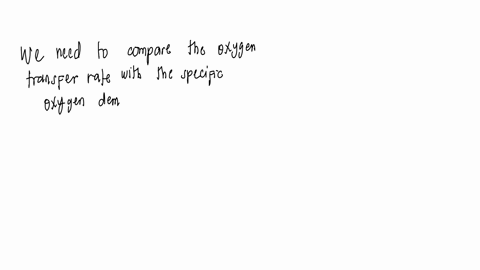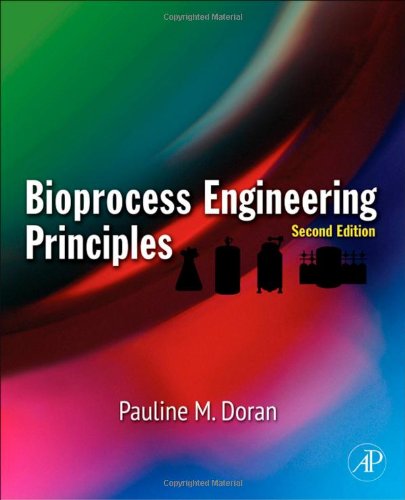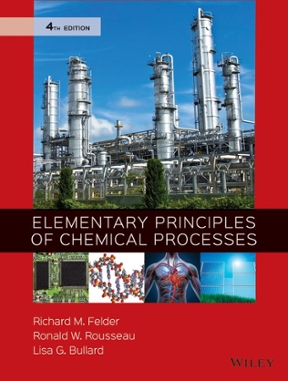Question
Rate of uptake of gas phase substrates. Experimental errors in determination of rates. Consider a well stirred laboratory reactor of volume 2 L which is used for continuous cultivation of $S$. cerevisiae. The reactor is sparged with $v_s=1.3 \mathrm{~L}$ air $\min ^{-1}$ The volume fraction of $\mathrm{O}_2$ in $v_{s f}$ is 20.96 $\% . \mathrm{T}=30^{\circ} \mathrm{C}$, and $\mathrm{p}=1 \mathrm{~atm}$. Assume, that $\nu_5=v_{\mathrm{g} t}$. a. Determine the rate of oxygen transfer $q_0{ }^t$ when the volume fraction of oxygen in the exhaust gas is $8.15 \%$. b. The oxygen tension in the reactor is measured to $25 \mu$ M. $s_0{ }^*$ is 1.20 mM when $\pi_{\mathrm{a}}=1 \mathrm{~atm}$. Determine the mass transfer coefficient $k a$. c. Determine the difference between $q_o^{\prime}$ and $-q_c$ when $s_{\mathrm{q} f}$ is $\cong 0$ and $v=600 \mathrm{~mL} \mathrm{~h}^{-1}$ d. The ethanol concentration in the liquid effluent from the reactor is measured to $4.2 \mathrm{~g} \mathrm{~L}^{-1}$. The inlet concentration is zero. Determine the rate of ethanol production ( C -moles $\mathrm{L}^{-1} \mathrm{~h}^{-1}$ ). Also determine the mole fraction of ethanol in the liquid. e. From physical chemistry the following relation is obtained between the liquid mole fraction $x$ and the gas phase mole fraction $y$. $$ y_i=\gamma_i x_i \frac{\pi_i^{s a t}}{p}=\frac{\pi_i}{p} $$ $\gamma_i$ is the activity coefficient, $p$ is the total pressure, and $\pi_i$ is the partial pressure of component $i$ in the gas phase. $\pi_i{ }^m$ is the vapor pressure of ethanol at the system at the system temperature $=$ 78.4 mm Hg at $30^{\circ} \mathrm{C}$ The activity coefficient for ethanol in water is quite high. Rarey and thermodynamic equilibrium is established between ethanol in the liquid phase and ethanol in the gas phase determine how much ethanol is being stripped to the gas phase ( C -moles $\mathrm{L}^{-1} \mathrm{~h}^{-1}$ ) when $v_{\mathrm{g}}=v_{\mathrm{g}}=1.3 \mathrm{~L} \mathrm{~min}^{-1}$. Compare with the ethanol produced by the bioreaction (question 4). Will the evaporated ethanol have a significant effect on $v_z$-i.e. will it invalidate the assumption that $v_{\mathrm{a}}=v_{\mathrm{ar}}$ ? f. $\pi_{480}^{\text {sar }}$ is 31.7 mm Hg at $30^{\circ} \mathrm{C}$. Assuming that dry air, $20.96 \%$ oxygen is used as feed to the reactor. What is the difference between $v_q$ and $v_z$ due to water evaporation? Again assume thermodynamic equilibrium between liquid and gas phase and $\gamma_{\text {moo }}=1$. Will the difference between $v_{\mathrm{g}}$ and $v_{\mathrm{g}}$ influence the answer to question a? g. In question 1 the same oxygen transfer rate would be obtained if $v_{\mathrm{g} t}$ was $6.5 \mathrm{~L} \mathrm{~min}{ }^{-1}$ and the exit prartial pressure of $\mathrm{O}_2$ was 0.1840 atm . Reconsider the answer to question 6 if we also here use the assumption $v_s=v_w$. The answer to this question explains why - One should try to have a significant difference in oxygen pressure between inlet and outlet. - The off-gas should be dried before measuring $\pi_{\mathrm{O}_2}$. (Christensen et al., 1995) The present problem is inspired by the experimental investigation of errors in measurement of oxygen uptake rates and ethanol production rates in bioreactors performed by Duboc and von Stockar (1998). This reference deserves a careful study as a preliminary to an experimental study of bioreaction rates.
Rate of uptake of gas phase substrates. Experimental errors in determination of rates. Consider a well stirred laboratory reactor of volume 2 L which is used for continuous cultivation of $S$. cerevisiae. The reactor is sparged with $v_s=1.3 \mathrm{~L}$ air $\min ^{-1}$ The volume fraction of $\mathrm{O}_2$ in $v_{s f}$ is 20.96 $\% . \mathrm{T}=30^{\circ} \mathrm{C}$, and $\mathrm{p}=1 \mathrm{~atm}$. Assume, that $\nu_5=v_{\mathrm{g} t}$.
a. Determine the rate of oxygen transfer $q_0{ }^t$ when the volume fraction of oxygen in the exhaust gas is $8.15 \%$.
b. The oxygen tension in the reactor is measured to $25 \mu$ M. $s_0{ }^*$ is 1.20 mM when $\pi_{\mathrm{a}}=1 \mathrm{~atm}$. Determine the mass transfer coefficient $k a$.
c. Determine the difference between $q_o^{\prime}$ and $-q_c$ when $s_{\mathrm{q} f}$ is $\cong 0$ and $v=600 \mathrm{~mL} \mathrm{~h}^{-1}$
d. The ethanol concentration in the liquid effluent from the reactor is measured to $4.2 \mathrm{~g} \mathrm{~L}^{-1}$. The inlet concentration is zero. Determine the rate of ethanol production ( C -moles $\mathrm{L}^{-1} \mathrm{~h}^{-1}$ ). Also determine the mole fraction of ethanol in the liquid.
e. From physical chemistry the following relation is obtained between the liquid mole fraction $x$ and the gas phase mole fraction $y$.
$$
y_i=\gamma_i x_i \frac{\pi_i^{s a t}}{p}=\frac{\pi_i}{p}
$$
$\gamma_i$ is the activity coefficient, $p$ is the total pressure, and $\pi_i$ is the partial pressure of component $i$ in the gas phase. $\pi_i{ }^m$ is the vapor pressure of ethanol at the system at the system temperature $=$ 78.4 mm Hg at $30^{\circ} \mathrm{C}$ The activity coefficient for ethanol in water is quite high. Rarey and thermodynamic equilibrium is established between ethanol in the liquid phase and ethanol in the gas phase determine how much ethanol is being stripped to the gas phase ( C -moles $\mathrm{L}^{-1} \mathrm{~h}^{-1}$ ) when $v_{\mathrm{g}}=v_{\mathrm{g}}=1.3 \mathrm{~L} \mathrm{~min}^{-1}$. Compare with the ethanol produced by the bioreaction (question 4). Will the evaporated ethanol have a significant effect on $v_z$-i.e. will it invalidate the assumption that $v_{\mathrm{a}}=v_{\mathrm{ar}}$ ?
f. $\pi_{480}^{\text {sar }}$ is 31.7 mm Hg at $30^{\circ} \mathrm{C}$. Assuming that dry air, $20.96 \%$ oxygen is used as feed to the reactor. What is the difference between $v_q$ and $v_z$ due to water evaporation? Again assume thermodynamic equilibrium between liquid and gas phase and $\gamma_{\text {moo }}=1$. Will the difference between $v_{\mathrm{g}}$ and $v_{\mathrm{g}}$ influence the answer to question a?
g. In question 1 the same oxygen transfer rate would be obtained if $v_{\mathrm{g} t}$ was $6.5 \mathrm{~L} \mathrm{~min}{ }^{-1}$ and the exit prartial pressure of $\mathrm{O}_2$ was 0.1840 atm .
Reconsider the answer to question 6 if we also here use the assumption $v_s=v_w$. The answer to this question explains why
- One should try to have a significant difference in oxygen pressure between inlet and outlet.
- The off-gas should be dried before measuring $\pi_{\mathrm{O}_2}$. (Christensen et al., 1995)
The present problem is inspired by the experimental investigation of errors in measurement of oxygen uptake rates and ethanol production rates in bioreactors performed by Duboc and von Stockar (1998). This reference deserves a careful study as a preliminary to an experimental study of bioreaction rates.
Show more…
Chapter 3, Problem 1

Instant Answer
Step 1
The volume flow rate of air is given as \( v_s = 1.3 \, \text{L/min} \) and the volume fraction of oxygen in the sparged air is \( 20.96\% \). Show more…
Show all steps











